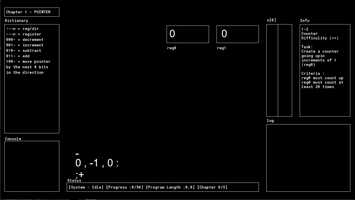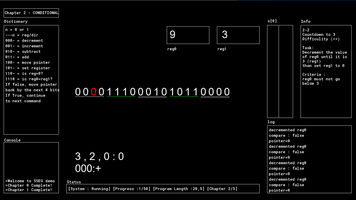SSEG Early Access Build





I have been developing this project on and off across the past month (along with another project), and am finally ready to release it, in an early access state.
SSEG (Single String Esolang Game) is a programming puzzle game about completing tasks using a simple programing language with 2 symbols. Start with simple counters and progress to generating the Fibonacci sequence and more complex tasks.
The game currently contains 5 chapters, with a total of 30 tasks for you to complete, using an assembly-like programing language of 1s and 0s.
2 more chapters are in development, which will involve ASSCI conversion and User Input, as well as more complex tasks.
If you find any issues, please report them in the comments.
Files
Get S²EG
S²EG
SSEG is a esolang programming puzzle game about completing tasks using a simple programing language with 2 symbols.
| Status | Released |
| Author | LaptopCoder11 |
| Tags | Abstract, binary, esolang, esoteric, problem-solving, sseg |
More posts
- S²EG Full ReleaseMar 25, 2023
- SSEG Chapter 5 - PRINT()Nov 07, 2022
Comments
Log in with itch.io to leave a comment.
On the 25th level and it has been amazing so far! Wanted to ask how the 24th and 25th should be done (3-3: Multiplication, 3-4: Division). I solved mult by just adding 1 a lot to 1 of the registers, this likely very incorrect approach doesn't work for division
My only thought is that I decrement reg 1, branching whenever it becomes 0 to do a separate counting up loop for a couple dividends, but this would be a lot of code, and calculating offsets will be a mess.
I also thought about self-modifying code, but it doesn't seem possible.
Is there maybe a separate mem region I can write to that will help?
hint : 3-3 and 3-4 don't require you to create general solutions that work for any values, although it is possible.
One solution to 3-4 is (rot13) gb guvax bhgfvqr gur obk naq uneqpbqr bar bs gur inyhrf (va guvf pnfr 4) naq erhfr ert1 nf n pbhagre.
Self-modifying code was one of the original ideas, but I didn't end up implementing it.
There is another memory region that is introduced in Chapter 4 which allows for general solutions for both multiplication and division, although anything before that is possible without using it.
Thank you. I had a feeling I was overthinking it. Can't wait to see the later chapters